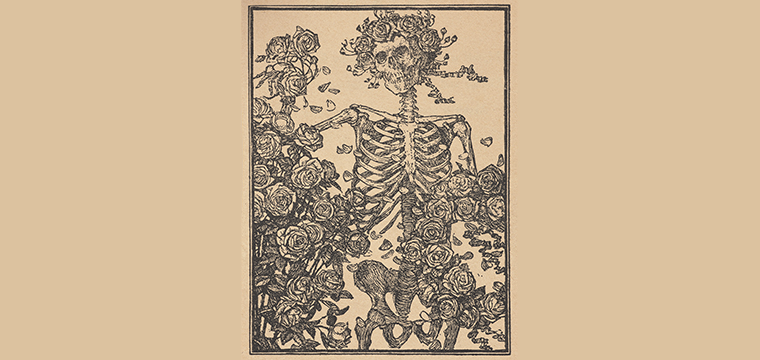Far out fashion is only part of the The Summer of Love Experience, currently on exhibit at the de Young Museum.

This original black and white drawing by Edmund Joseph Sullivan drawing was an illustration for a 1913 edition of the Rubaiyat of Omar Khayyam. Later, Alton Kelley and Stanley Mouse added lettering and color and it was used as the cover for the album Grateful Dead (1971).
BY PAUL DUCLOS
Published: May, 2017
Far out fashion is only part of the The Summer of Love Experience, currently on exhibit at the de Young Museum. Also on display are iconic rock posters, photographs, interactive music and light shows, costumes and textiles, ephemera and avant-garde films.
“The 1967 Summer of Love was a defining moment in San Francisco’s history,” said Max Hollein, Director and CEO of the Fine Arts Museums of San Francisco. “With the de Young’s proximity to the Haight-Ashbury district, our exhibition is the cornerstone of a city-wide celebration. The work created during this period remains a significant legacy and we are uniquely positioned to present this story in all of its controversial glory.”
A 50th anniversary celebration of the adventurous and colorful counterculture that blossomed in the years surrounding the legendary San Francisco summer of 1967, the exhibition presents more than 400 significant cultural artifacts of the time, including almost 150 objects from the Fine Arts Museums’ extensive permanent holdings, supplemented by key, iconic loans.
As some of us remember, artists, activists, writers and musicians converged on Haight-Ashbury with hopes of creating a new social paradigm. By 1967, the neighborhood would attract as many as 100,000 young people from all over the nation. The neighborhood became ground zero for their activities, and nearby Golden Gate Park their playground.
The period is marked by groundbreaking developments in art, fashion, music and politics. Local bands such as Jefferson Airplane and the Grateful Dead were the progenitors of what would become known as the “San Francisco Sound”—music that found its visual counterpart in creative industries that sprang up throughout the region. Rock-poster artists such as Rick Griffin, Alton Kelley, Victor Moscoso, Stanley Mouse and Wes Wilson generated an exciting array of distinctive works featuring distorted hand-lettering and vibrating colors, while wildly creative light shows, such as those by Bill Ham and Ben Van Meter, served as expressions of the new psychedelic impulse.
Distinctive codes of dress also set members of the Bay Area counterculture apart from mainstream America. Local designers began to create fantastic looks using a range of techniques and materials, including leatherwork, hand-painting, knitting and crotchet, embroidery, repurposed denim and tie-dye. These innovators included Birgitta Bjerke, also known as 100% Birgitta; Mickey McGowan, also known as the Apple Cobbler; Burray Olson; and Jeanne Rose.
“Our collections have always reflected our interest and respect for this period in Bay Area history,” said Jill D’Alessandro, curator of textile and costume arts at the Fine Arts Museums of San Francisco. “The scope and scholarship of this exhibition weave the many threads of this story together to create a new context and narrative that is both reverential and refreshing.”
Presidio Special Exhibition Explores Japanese Internment
On a more sobering note: Alcatraz and Angel Island both have their tragic historical back stories, but few ferry passengers probably realize that the Presidio could also generate painful memories of confinement and isolation.
During World War II, the Presidio of San Francisco—the Army’s Western Defense Command—played a pivotal role in the unjust internment of 120,000 Japanese Americans. Exclusion, a special exhibition now displayed at the Presidio Officers’ Club, marks 75 years since Lieutenant General John L. DeWitt issued civilian exclusion orders from the Presidio, and examines the post’s little understood part in these events.
The exhibition invites visitors to investigate the choices—both personal and political—that led to this dark chapter in American history. How did leaders arrive at this decision? How did Japanese-Americans respond to the violation of their civil liberties? And what, as a nation, have we learned that can help us address the present-day issues of immigration, racism and mass incarceration?
The Presidio Officers’ Club is a cultural institution showcasing the Presidio’s role in shaping and serving the nation. Its special exhibitions explore the Presidio’s heritage and allow for fresh perspectives and a deeper exploration of the topics and themes presented in the club’s permanent exhibition.
Follow Paul Duclos’ Cultural Currents online with his blog at: paulduclosonsanfranciscoculture.blogspot.com

